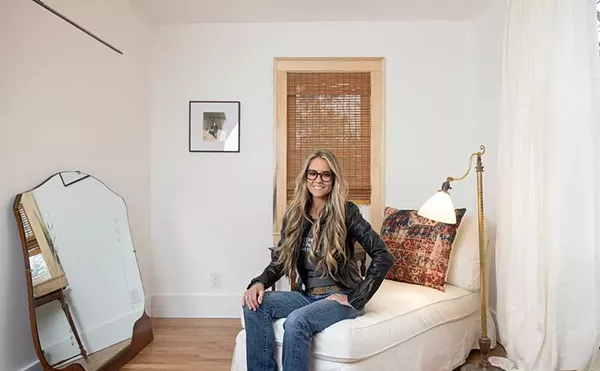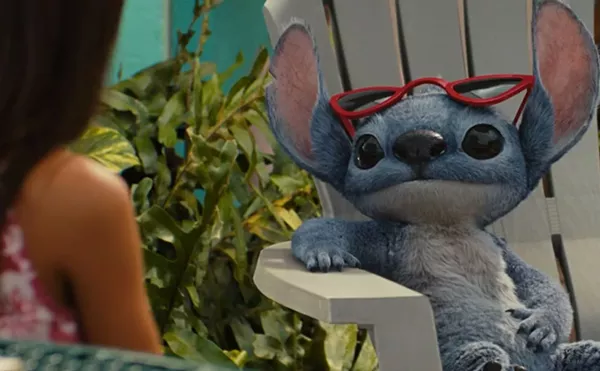
Audio By Carbonatix
[
{
"name": "GPT - Leaderboard - Inline - Content",
"component": "35519556",
"insertPoint": "5th",
"startingPoint": "3",
"requiredCountToDisplay": "3",
"maxInsertions": 100,
"adList": [
{
"adPreset": "LeaderboardInline"
}
]
}
]
Last Friday, another shining addition to Detroit’s rapidly growing art community — City Gallery — opened its doors in the First National Building at the corner of Woodward and Cadillac Square. Owner Debbie Rupp feels that the location is perfect since she’s been getting many people coming in off the street, just passing by and spotting the new digs through the windows. She says, “Our goal is to represent artists who reside in Detroit and showcase artists from other areas as well, in order to expose people to all kinds of art — both local and from elsewhere.”
A longtime supporter of Tyree Guyton’s work, Rupp asked if he would do a show of new paintings for the gallery’s inaugural exhibit and he gladly agreed. As a result, City Gallery proudly presents “Smiles & Smiles to Go: A Collection of Works Inspired by Faces from All Over the World.” Guyton remains an important part of the fabric of art and culture in Detroit. And his show overflows with bright, lovely, large and round smiling faces on his signature car hoods, on wood and other surfaces.
The element of nature plays an important role throughout Guyton’s process. He picks up “junk” people have thrown away — old boards, chunks of demolished and decayed structures — and resurrects it into something beautiful. He keeps the integrity of the material, the nails and original paint (chips and all) intact. In the case of “Crossroads,” he has left what appears to be a piece of paper that may have been attached to a board for 10 years, and taken his brush right over it, creating the contour of one of his faces. The flaws in the wood only add to the personality of the piece.
In addition to using worn boards as a starting point, Guyton seasons the paintings in progress by leaving them outside for days, months or years. He periodically checks a work as it’s being weathered until he feels it’s ready.
Each portrait in the current show represents people, some anonymous, from Guyton’s life. But instead of trying to create a likeness, he pulls from an intuitive feeling about the person. A piece called “Sister Davis” portrays a woman with Guyton’s usual vibrant colors and multiple rows of beaming teeth. Showing his “harmony with the spiritual side of life,” he has scrawled the word “God” on her forehead.
Guyton explains, “The idea of faces comes from the Bible, from scripture. Man was made in His likeness. There are six billion people in the world today and knowing that everyone has their own unique face — I think that’s incredible.
“I grew up in a sanctified family. I was forced to go to church. But it gave me a foundation. Sister Davis was a very religious person from my church back when I was a kid. She would sing to the glory of God. Her voice was so powerful that it sent chills all over my body.”
Guyton finds a unification between all peoples, as all people wearing the face of God. In regards to the painted grins, he says, “Those are my smiles. Today I’m at a point where I’m really happy. I’ve been through a lot. In whatever happens, I’ve learned to face everything with a smile.”
Optimism pervades everything Guyton does. With every color, every stroke of paint, we sense his hope for a glorious future. But the artist says he doesn’t try to change the world, “only myself,” he insists. “And from that the world will change.”
Facing adversity head-on has been familiar to Guyton. For many years, he unwaveringly fought so that his world-famous kaleidoscopic vision, the Heidelberg Project, would continue to stand for future audiences. And he has won. Heidelberg still exists, although 60 percent of it has been destroyed by the City of Detroit. The battle was long and hard, but Guyton survived and the project endures, since the remaining work sits on private property that the city can’t touch.
“They can never take Heidelberg away — it’s too late now. Heidelberg will never die. I took an area that was dead and I gave it life. And it’s going to live on.”
City Gallery is located inside the First National Building, 660 Woodward, Detroit. Call 313-963-0101for more info.
Liz DiDonna writes about art for the Metro Times. E-mail her at letters@metrotimes.com




